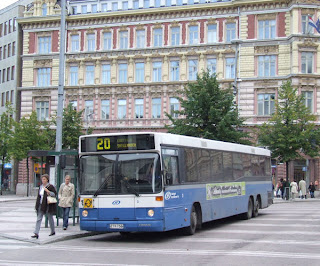 The city of Helsinki lies on the Gulf of Finland. Around 600,000 people live in the city itself, while the Helsinki metropolitan area as a whole is home to more than 1.3million, roughly a quarter of the population of Finland as a whole. Compared to most other European capital cities, Helsinki has a relatively low population density.
The city of Helsinki lies on the Gulf of Finland. Around 600,000 people live in the city itself, while the Helsinki metropolitan area as a whole is home to more than 1.3million, roughly a quarter of the population of Finland as a whole. Compared to most other European capital cities, Helsinki has a relatively low population density. The Finnish capital is another Olympic host city added to this blog - Helsinki hosted the Olympic Games in 1952.
Some of Helsinki's neoclassical architecture may look similar to that found in the Russian city of St. Petersburg, 300km to the east. That is no coincidence. Finland was under Russian sovereignty for much of the 19th Century and Helsinki's buildings in that era were influenced by the architecture of St. Petersburg.
As well as a suburban rail network, Helsinki has Finland's only metro system, opened in 1982, and the country's only tram system. The transport network in Helsinki is co-ordinated by Helsinki Region Transport (HRT/HSL). Trams are operated by HKL, as is the metro.
These articulated vehicles form the backbone of the Helsinki tram fleet. They were not built with wheelchair access but some (maybe all) have had an additional low-floor section added since I took these photos. This video demonstrates the manually-operated wheelchair ramps fitted to these trams.
Many displayed just a route number, although some have been modified to enable the destination to be shown.
When a destination is displayed, it is shown in both the Finnish and Swedish languages. Swedish is the first language of around 5% of the Finnish population. Helsinki is one of a number of Finnish settlements where both languages are officially recognised.




There are also newer, low-floor trams. Here is a selection of images:



The oldest tram I saw on the streets was this one, being used for a private hire.
Bus services run into the centre of Helsinki from districts which are not served by rail, metro or tram. Otherwise, the bus network operates as feeders to the rail-based routes. Bus services are planned and tendered by HRT, with several operators running the buses. All the buses I found were single-deck, mostly standard two-axle vehicles.


Even where a destination is the same in both Finnish and Swedish, it is displayed separately in each language.
As with the trams, not all of the buses displayed destinations.

As well as standard two-axle vehicles, there were also some longer-length three-axle buses operating.



I didn't see any articulated buses in Helsinki while the only double-deckers were open-top vehicles on sightseeing tours.
Images in this post are from my visit to Helsinki in 2008. They reflect what I found then. Some of the fleets may have been updated since.










No comments:
Post a Comment